Like so many great art forms, dance is a series of interlinked relationships and memories, a tradition that continually redefines and reinvents itself. It lives in the past, and the present, and the future, and its story is written in the memories and associations of open-hearted observers as well as the muscles of dancers and the patterns in choreographers’ minds.
Dance writer Martha Ullman West, one of our best observers, took in last Friday’s Dance United, and for her it was like biting into a madeleine: The reminiscences and connections just began to flow. Somehow, no matter how far-flung, they all looped back to Oregon Ballet Theatre, its history and successes, and this extraordinary event to keep the company alive and vital.
Here is the link to Martha’s review in The Oregonian of the performance. And here, below, is her more personal report on what it all meant:
———————————————————————-
 Really, it was a cross between a potlatch and an Obama rally, a gathering of the clans.
Really, it was a cross between a potlatch and an Obama rally, a gathering of the clans.
Dancers came from Texas, Utah, Massachusetts, Canada, Washington state, California, Chicago, Idaho, and that other geographical location, in New York called Downtown, here designated as Portland’s modern and contemporary dance community.
The gifts they brought were generous: their talent and their time. And they were welcomed to Keller Auditorium with the same enthusiasm as Obama’s supporters do and did, reaching into their wallets with many relatively small donations to keep Oregon Ballet Theatre alive. On Tuesday, OBT had in hand $720,000 of the $750,000 it needs to make up THIS season’s deficit.
I’ve been watching dance in Portland and elsewhere for more decades that I wish to reveal, and professionally since 1979, when I wrote an essay on postmodern dance in New York for Dance Magazine. In so many ways, this gala triggered some Proustian moments, also making me think of all the ways that dance and dancers are connected to each other.
Linda Austin’s thoroughly postmodern “anybody-can-dance, any-movement-on-stage-is-valid” Boris & Natasha Dancers (on catnip) took me back to New York’s SoHo and a performance created by Karole Armitage consisting of a group of dancers on their hands and knees, painting stripes on the floor, in humorless silence. They were not skilled at either painting or dancing, but it was the same democratic approach to the art form as Austin’s new dance, which featured such pillars of the Portland community as two Bragdons (Peter and David), Scott Bricker, James Harrison and Peter Ames Carlin galumphing across the stage, one of them wearing red sneakers that I wondered if he’d borrowed from White Bird’s Paul King. (Armitage, you may remember, also made work on OBT’s dancers on James Canfield’s watch.)
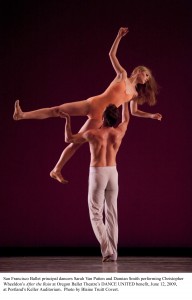 The Joffrey Ballet’s Aaron Rogers, performing Val Caniparoli’s Aria, recalled for me the profound pleasure of watching Val work with Portland dancers, first at OBT’s precursor Ballet Oregon, and then at OBT. Caniparoli’s kindness and courtesy in the studio turned out to be extremely productive when the company performed his Street Songs and other work. Rogers looked like he was enjoying himself, flirting with that mask, and certainly seduced the audience in the process.
The Joffrey Ballet’s Aaron Rogers, performing Val Caniparoli’s Aria, recalled for me the profound pleasure of watching Val work with Portland dancers, first at OBT’s precursor Ballet Oregon, and then at OBT. Caniparoli’s kindness and courtesy in the studio turned out to be extremely productive when the company performed his Street Songs and other work. Rogers looked like he was enjoying himself, flirting with that mask, and certainly seduced the audience in the process.
And I thought about Mark Goldweber, ballet master at OBT under Canfield, then for some years at the Joffrey, and now at Ballet West. (He gave the only authentic performance in Robert Altman’s dance film The Company, in my view.) I wondered what Mark thinks about the way Adam Sklute, now Ballet West’s artistic director, staged this version of the White Swan pas de deux.
When I encountered this ballet’s real-life Prince Siegfried, Christopher Ruud, at OBT’s studios earlier in the week, I spoke with him about his father, who had helped Todd Bolender at Kansas City Ballet (Bolender is the subject of a book I’m working on). Ruud told me he had staged one of his father’s pieces on the company several years ago.
Continue reading Martha Ullman West on Dance United: a personal take →
 Update: Walter Jaffe at White Bird Dance has passed along this note from Keith Goodman’s friend Carla Mann: “Dear friends, I wanted to let you know that a gathering to celebrate Keith Goodman will be held this coming Thursday, July 2 from 4-6pm at the Gerding Theater, 128 NW 11th. Please join family and friends in honoring this incredible man. Please also spread the word to others who knew Keith and who we may not be on our contact list. For those who are interested, contributions can be made to the Keith V. Goodman Memorial Fund through the On Point Credit Union.”
Update: Walter Jaffe at White Bird Dance has passed along this note from Keith Goodman’s friend Carla Mann: “Dear friends, I wanted to let you know that a gathering to celebrate Keith Goodman will be held this coming Thursday, July 2 from 4-6pm at the Gerding Theater, 128 NW 11th. Please join family and friends in honoring this incredible man. Please also spread the word to others who knew Keith and who we may not be on our contact list. For those who are interested, contributions can be made to the Keith V. Goodman Memorial Fund through the On Point Credit Union.” By MARTHA ULLMAN WEST
By MARTHA ULLMAN WEST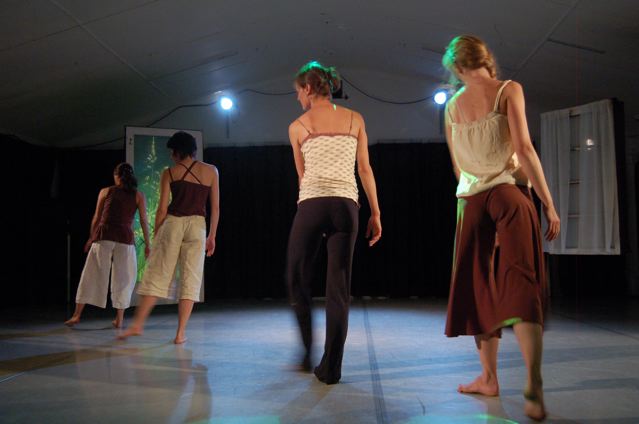
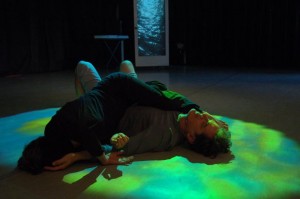 The show began with TouchMonkey, in the persons of Carolyn Stuart and Patrick Gracewood, who are longtime practitioners of Contact Improvisation, a form based on trust and the ability to make on-the-spot kinetic connections. Stuart was wearing a black cloth over her eyes, which meant her responses to Gracewood were entirely by touch and contact. Their duet, titled Special Alembics, (nice pun!) was performed to music played live by Eddy Deane, Alley Teach, and David Lyles of The Contact Lounge Band.
The show began with TouchMonkey, in the persons of Carolyn Stuart and Patrick Gracewood, who are longtime practitioners of Contact Improvisation, a form based on trust and the ability to make on-the-spot kinetic connections. Stuart was wearing a black cloth over her eyes, which meant her responses to Gracewood were entirely by touch and contact. Their duet, titled Special Alembics, (nice pun!) was performed to music played live by Eddy Deane, Alley Teach, and David Lyles of The Contact Lounge Band.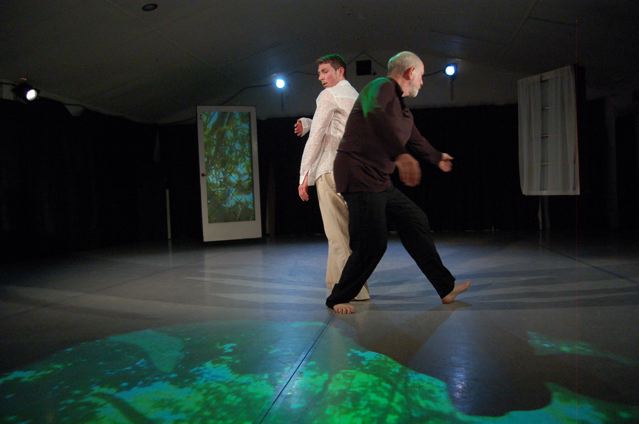
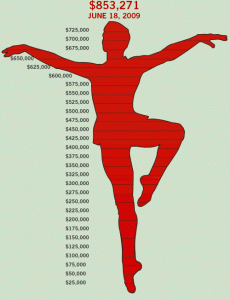 While Art Scatter was spending Thursday in the Columbia Gorge visiting the
While Art Scatter was spending Thursday in the Columbia Gorge visiting the  Really, it was a cross between a potlatch and an Obama rally, a gathering of the clans.
Really, it was a cross between a potlatch and an Obama rally, a gathering of the clans. The Joffrey Ballet’s Aaron Rogers, performing Val Caniparoli’s Aria, recalled for me the profound pleasure of watching Val work with Portland dancers, first at OBT’s precursor Ballet Oregon, and then at OBT. Caniparoli’s kindness and courtesy in the studio turned out to be extremely productive when the company performed his Street Songs and other work. Rogers looked like he was enjoying himself, flirting with that mask, and certainly seduced the audience in the process.
The Joffrey Ballet’s Aaron Rogers, performing Val Caniparoli’s Aria, recalled for me the profound pleasure of watching Val work with Portland dancers, first at OBT’s precursor Ballet Oregon, and then at OBT. Caniparoli’s kindness and courtesy in the studio turned out to be extremely productive when the company performed his Street Songs and other work. Rogers looked like he was enjoying himself, flirting with that mask, and certainly seduced the audience in the process.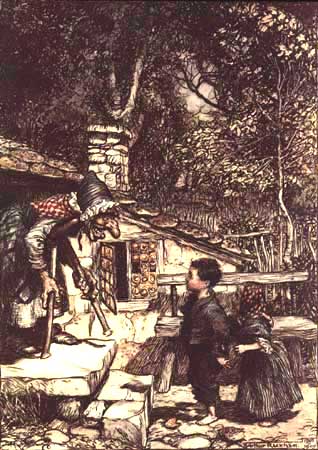 The smashing success of last Friday’s
The smashing success of last Friday’s 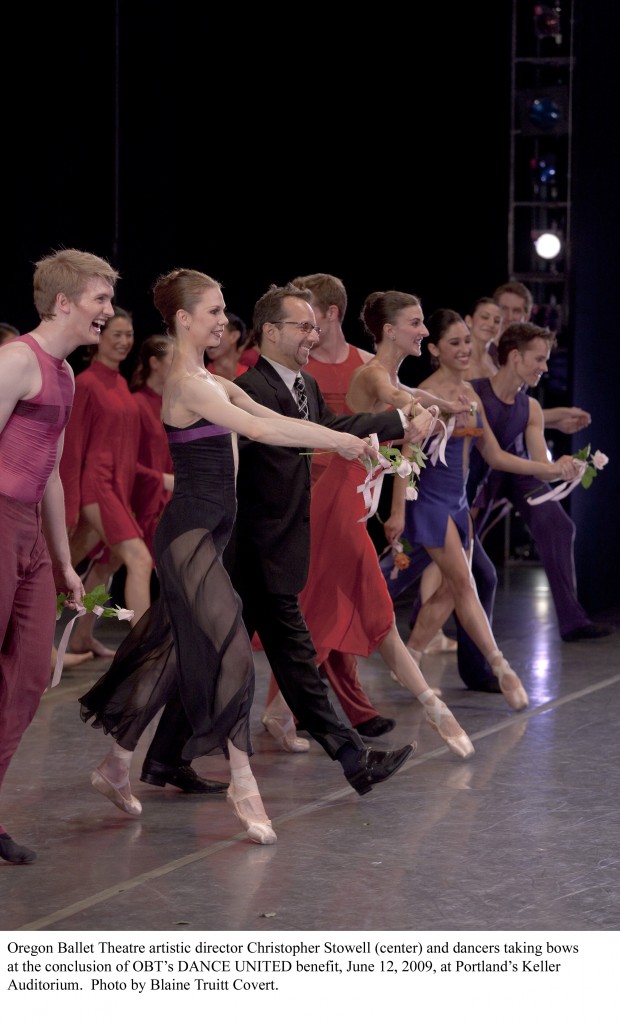
 THE LATEST NEWS FROM OREGON BALLET THEATRE, which is struggling with a life-threatening deficit that has it feverishly trying to raise $750,000 by June 30 to keep from going out of business: The campaign hit the $524,000 mark by Wednesday. That morning OBT’s Erik Jones said 900 tickets were still available for Friday night’s gala benefit performance Dance United, which will bring star performers from across North America to raise money for OBT. Buy your tickets
THE LATEST NEWS FROM OREGON BALLET THEATRE, which is struggling with a life-threatening deficit that has it feverishly trying to raise $750,000 by June 30 to keep from going out of business: The campaign hit the $524,000 mark by Wednesday. That morning OBT’s Erik Jones said 900 tickets were still available for Friday night’s gala benefit performance Dance United, which will bring star performers from across North America to raise money for OBT. Buy your tickets  OBT’s season-finale program was designed to accomplish several goals, one of which was to challenge the dancers. And there is no getting around the fact that the work those dancers had performed most often — Rush, Afternoon of a Faun and The Concert — was polished to the accomplished shine you see only in major companies: New York City Ballet, San Francisco Ballet, Pacific Northwest Ballet, Houston Ballet and the like. These are troupes with far bigger budgets, many more dancers and far more opportunities to perform than OBT.
OBT’s season-finale program was designed to accomplish several goals, one of which was to challenge the dancers. And there is no getting around the fact that the work those dancers had performed most often — Rush, Afternoon of a Faun and The Concert — was polished to the accomplished shine you see only in major companies: New York City Ballet, San Francisco Ballet, Pacific Northwest Ballet, Houston Ballet and the like. These are troupes with far bigger budgets, many more dancers and far more opportunities to perform than OBT.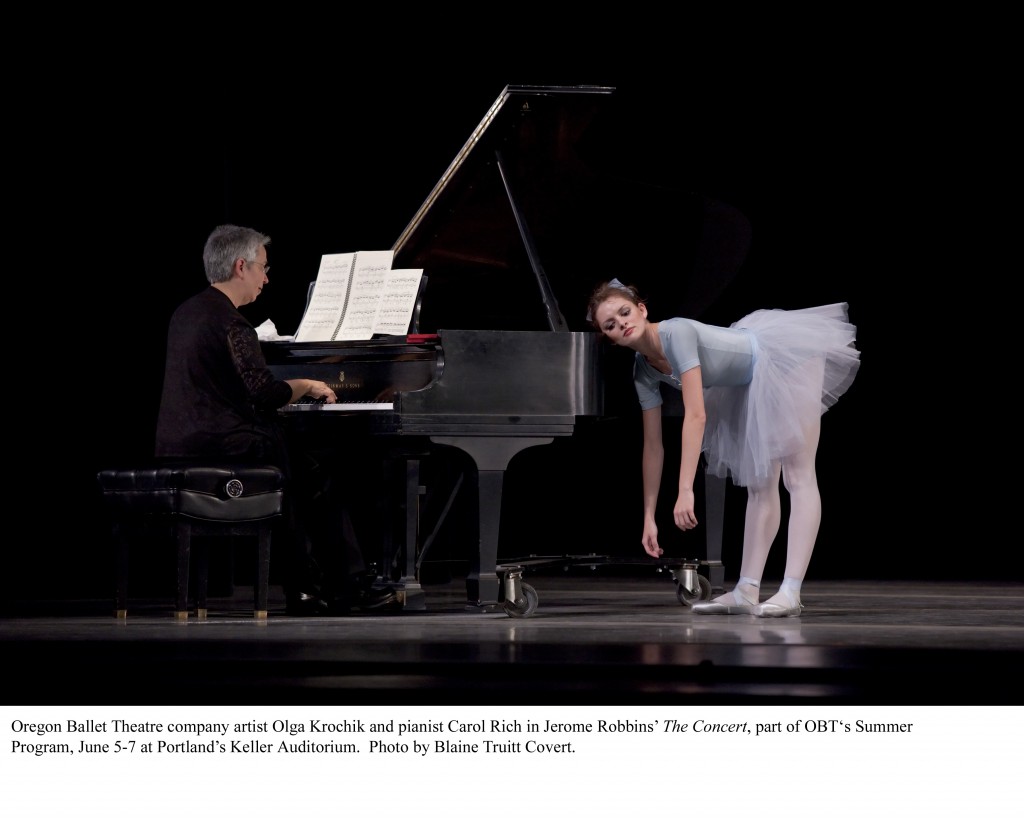
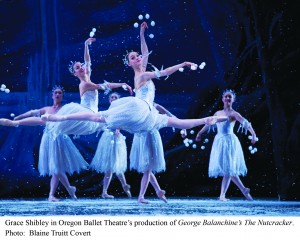 You’ve read
You’ve read